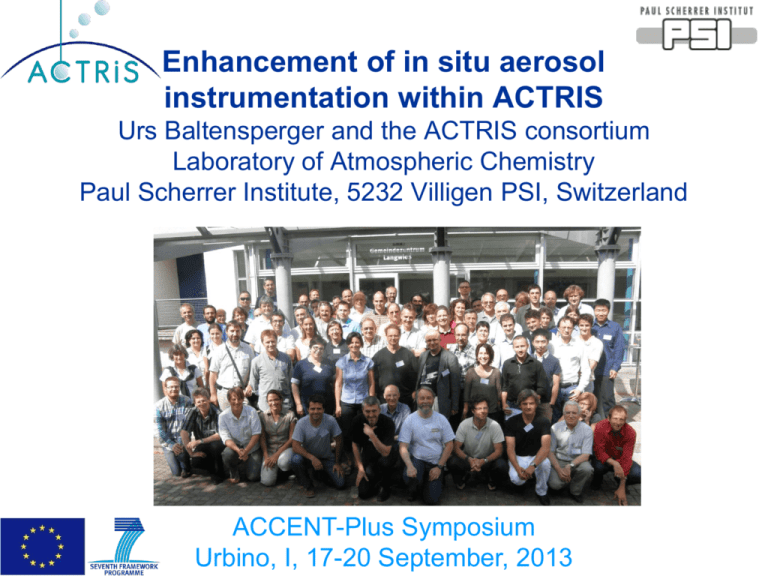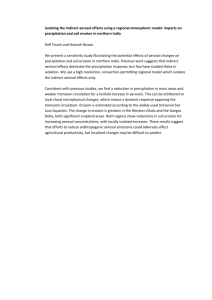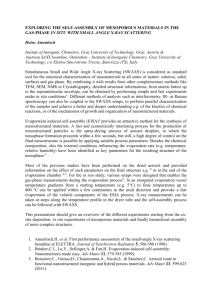Enhancement of in situ aerosol instrumentation within ACTRIS
advertisement

Enhancement of in situ aerosol instrumentation within ACTRIS Urs Baltensperger and the ACTRIS consortium Laboratory of Atmospheric Chemistry Paul Scherrer Institute, 5232 Villigen PSI, Switzerland ACCENT-Plus Symposium Urbino, I, 17-20 September, 2013 Objectives of ACTRIS Aerosols, Clouds, and Trace gases Research Infrastructure Network • To provide long-term observational data relevant to climate and air quality research on the regional scale produced with standardized or comparable procedures • to support trans-national access to large infrastructures and access to high-quality information and services for the user communities • To develop new integration tools to fully exploit the use of multiple atmospheric techniques at ground-based stations • To enhance training of new scientists and new users • To promote development of new technologies for atmospheric observation of aerosols, clouds and trace gases through close partnership with EU SMEs Components and sites of ACTRIS • • • • In situ aerosol In situ gas phase Remote sensing aerosol Remote sensing clouds Work packages contributing to in situ aersol measurements Two work packages contributing to aerosol in situ measurements: •Networking Activity: In-situ chemical, physical and optical properties of aerosols •Joint Research Activity: Comprehensive gas phase and aerosol chemistry Builds on previous EU projects (CREATE, EUSAAR) ACTRIS has adopted a wide number of the aerosol variables recommended by GAW Variable: - Multiwavelength optical depth: - Mass in two size fractions - Major chemical components in two size fractions: - Scattering and hemispheric backscattering coefficient at various wavelengths: - Absorption coefficient: - Aerosol number concentration: - Cloud condensation nuclei (at various supersaturations): - Aerosol size distribution - Detailed size fractionated chemical composition - Dependence on relative humidity - Vertical distribution of aerosol properties (LIDAR): ACTRIS lead: Calibration service Instrumentation assessment OC/EC, Organic tracers, carbon balance Intercomparison Intercomparison Intercomparison SOP development Intercomparison Instruments, algorithms,… Size distribution measurements: Several intercomparisons in the last decade, much progress but still large discrepancies at small diameters Wiedensohler et al., AMT 2012 Atmospheric background conditions can profitably be studied by means of continuous monitoring activities at High Mountain Stations that provide unique opportunities to detect and analyses global change processes also through the observations of SLCF Black carbon and Ozone are continuously monitored at the high mountain GAW-WMO Global stations of Monte Cimone (2165 m) The Po Valley (Italy) seen from Mt. Cimone GAW station during a polluted summer day in the Summer 2006 Italian Northern Apennines and Nepal Climate Observatory @ Pyramid (5079 m) Southern Himalaya. Black carbon @ MTC NCO-P Ozone @ Mt. Cimone Black carbon and ozone are SLCF, shortlived climate forcer: they only stay in the atmosphere for a few days to weeks. The ABC pollution in Himalaya seen from Both sites are close to the NCO-P at 5079 m asl in April 2009 polluted areas Ozone @ NCO-P characterized by presence of Atmospheric Brown Clouds Photos P.Bonasoni ACTRIS has strong connection to EMEP Example 2012 Campaign: See talk by Wenche Aas Mineral dust 14 EMEP / ACTRIS sites PM10 - Low volume sampling Particle Induced X-ray Emission (PIXE) 14 13 12 5 11 6 3 4 2 10 1 9 8 7 EMEP Report 4/2013 EMEP 2012 Campaign: Saharan dust outbreaks, links to models EMEP Report 4/2013 Continuous on-line chemistry measurements with the ACSM Old version: Quadrupol MS New version: ToF MS Stations of the ACSM network Many additional stations besides the original 6 stations great mobilization of additional resources Finokalia, Crete Long-term measurements of optical properties 1200 Scattering coef. 90 Scattering coef. (Mm-1) Absorption coef. 1000 80 70 800 60 50 600 40 400 30 20 200 10 0 2001 0 2002 2003 2004 2005 2006 2007 2008 2009 2010 2011 ACSM measurements summer 2012 Absorption coef. (880 nm, ng/m3) 100 Fracti 0.2 1 year ACSM at Cabauw, Netherlands 0.0 Organics Nitrate Sulfate Ammonia Chloride Mass / µg/m³ 40 30 20 10 0 10.08.2012 19.09.2012 29.10.2012 08.12.2012 17.01.2013 26.02.2013 07.04.2013 17.05.2013 Date and time Comparison ACSM and ToF-AMS 3.0 3.0 1.5 Org 1.0 2 2.0 1.5 R =0.73 m=1.13 0.5 0.0 NO3 1.0 2 R =0.87 m=1.32 0.5 0.5 1.0 1.5 2.0 Mass Concentration HR-ToF-AMS 2.5 3.0 0.0 1.2 1.2 NH4 1.0 R =0.72 m=0.92 1.0 0.8 0.6 SO4 0.4 2 R =0.76 m=0.54 0.2 0.0 0.0 0.0 1.4 Mass Concentration ACSM 2.0 Mass Concentration ACSM 2.5 Mass Concentration ACSM Mass Concentration ACSM 2.5 1.4 0.5 1.0 1.5 Mass Concentration HR-ToF-AMS 2.0 2.5 2 0.8 0.6 0.4 0.2 0.0 0.0 0.5 1.0 1.5 Mass Concentration HR-ToF-AMS Good correlation, SO4 factor 2 lower 2.0 0.0 0.2 0.4 0.6 0.8 Mass Concentration HR-ToF-AMS 1.0 Average chemical composition at different sites Birkenes 2.5 2.0 1.5 1.0 0.5 0.0 Aug des-feb Average chemical composition at different sites (2) Paris 8 7 6 Cl 5 NO3 4 SO4 3 NH4 2 OM 1 0 JJA (2012) DJF (2012-13) One-year data set of the ToF-ACSM from the Jungfraujoch Fröhlich et al., in prep. First source apportionment with positive matrix factorization Using a standardized PMF tool developed at PSI (Canonaco et al., AMTD 2013) Fröhlich et al., in prep. Provision of ground based aerosol in situ data within ACTRIS Yearly reporting deadline See also Posters by Ann Mari Fjaeraa All data are available from http://ebas.nilu.no 2012 data: 31. July 2013, following EMEP deadlines 24 sites from 15 European countries have reported QA aerosol in situ data since start of ACTRIS Trend analysis: a crown jewel of data usage Collaud Coen et al., ACP 2013 Asmi et al., ACP 2013 While only a few sites were available with a least a 10-year data record here, many more sites are expected to be involved in the next analysis, thanks to ACTRIS (and other initiatives within the Global Atmosphere Watch Program) The ACTRIS Roadmap 2011-2020 Conclusions • ACTRIS has continued/enhanced the success of previous EU FP programes like CREATE, EUSAAR, EARLINET • ACTRIS has a central role on data harmonization not only in Europe but globally • ACTRIS has pushed forward a number of innovative instrumental developments from which the whole world profits • ACTRIS does not only create a data repository, but is also actively involved in dissemination / usage of the data • It is important to get ACTRIS on the European Research Infrastructure map Thank you very much for your attention ! Spatial variability of aerosols Concentrations and trends of aerosol much more variable than e.g. of CO2 400 Mixing ratio (ppm) 390 380 370 CO2_MaunaLoa 360 CO2_JFJ_Empa_cont CO2_JFJ_UniB_cont 350 340 330 320 Jan 74 Jun 79 Dez 84 Jun 90 Nov 95 Mai 01 Nov 06 Mai 12 Components and sites of ACTRIS In situ aerosol In situ gas phase Remote sensing aerosol Remote sensing clouds Data availability of ACSM network Long-term measurements of chemical composition with the TOF-ACSM Clearly better than the Q-ACSM Fröhlich et al., AMTD 2013 Saharan dust - NAOi • NAO affects frequency of Saharan dust intrusions over Iberian Peninsula •Correlation improves with proximity to Atlantic Ocean •If NAO extremely positive or negative, effects felt across the Peninsula 2002-2010 Frequency of Saharan dust intrusions (days) North 30 South Central East North East 2 R =0.73 2 R =0.54 2 R =0.42 2 R =0.40 2 R =0.35 25 20 15 10 5 0 -3 -2 -1 0 1 2 NAOi Cusack, M et al. Atmospheric Chemistry and Physics, 12, 8341-8357, 2012 Trends of aerosol components: Montseny 2002-2010 Sharp reduction since 2008: economic recession + meteo 5 4 3 2 Sn Cu jul 2010 ene 2010 jul 2009 ene 2009 jul 2008 ene 2008 jul 2007 ene 2007 jul 2006 ene 2006 jul 2005 ene 2005 jul 2004 ene 2004 jul 2003 ene 2003 -3 1.0 0.8 0.6 0.4 0.2 Pb Sb Sb (ng m ) 10 8 6 4 2 0 jul 2002 -3 -3 -3 OC (µg m ) NO3- (µg m ) -3 Cu (ng m ) Nitrate -3 -3 2.5 2.0 1.5 1.0 0.5 Sn (ng m ) Pb (ng m ) OC Ammonium -3 6 4 2 0 2.0 1.5 1.0 0.5 Meteorology + pollution abatement strategies 5 4 3 2 1 NH4+ (µg m ) 4.0 3.0 2.0 1.0 Sulphate V -3 4 3 2 1 V (ng m ) SO42- (µg m ) Gradual replacement of fuel-oil with natural gas for power generation Cusack, M et al. Atmospheric Chemistry and Physics, 12, 8341-8357, 2012 EMEP 2012 Campaign: Mineral dust 14 EMEP / ACTRIS sites Low volume sampling Particle Induced X-ray Emission (PIXE) (µg/m3) Mineral load: obtained by the addition of the SiO2, Al2O3, Fe2O3 concentrations, and the dust contribution of Na2O, K2O, CaO and MgO after the subtraction of their marine contribution from the bulk concentrations EMEP Report 4/2013 Distribution of sites +Armenia 05.10.09 Total observed organic carbon (TOOC)concept Corinne Hörger, Stefan Reimann Part of ACTRIS WP 2.2 WANTED: Data from different stations (same time period) Gaseous substances (VOC, OVOC, monoterpenes) Particulate organic substances Data from Hohenpeissenberg 16 others 14 aromatics organic carbon [ug C/m3] MVK+Methacrolein 12 isoprene monoterpenes 10 formaldehyde acetaldahyde 8 ethanol 6 methanol 4 butane acetone propane ethane 2 OC aerosol 0 HPB Data from DWD HPB and Empa Corinne Hörger, Stefan Reimann






